The TC-200M was made for the Ricoh Mirai film camera which has a fixed 35mm to 135mm zoom lens. The number 200 in TC-200M means this lens extends Mirai's focal length to 200mm, and hence it is a 1.5X teleconverter lens (i.e., 200mm = 135×1.5). Since the Ricoh Mirai was released in 1988 and the TC-200M was available shortly after, they have been around for nearly twenty years. Due to its good quality, many film shooters put the TC-200M on a telephoto or zoom lens as a low cost front-mounting telephoto extender. This lens also has good reputation among many digital shooters for its light weight and good image quality. However, the TC-200M has become a rare item. It does not even show up on eBay frequently. If you can find one in good condition, you are really a lucky person.
TC-200M came with a lens pouch and front and rear cap. The lens has a 52mm rear thread, and a 55-52mm step-down ring is required to mount the lens on a Panasonic FZ-30 pr FZ-50. The lens has no front thread; however, one can jam a 67mm thread filter into the lens tube. The left image below shows the lens and its front and rear caps, while the right image below has it mounted on a Panasonic FZ-30 with the help of a 55-52 step-down ring.
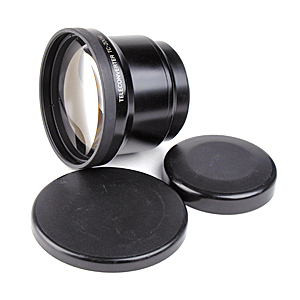
|
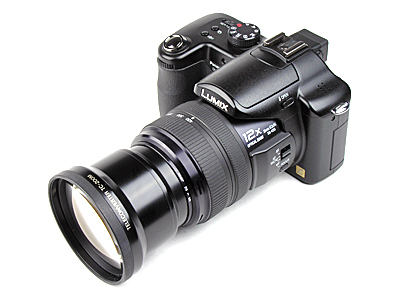
|
Since Ricoh discontinued this lens long time ago, it is not easy to find one. Occasionally, this TC-200M can be found on eBay sold with the Ricoh Mirai or other film cameras. Therefore, if you could not find a Ricoh TC-200M, try to search Mirai or Mirai 135 (rather than Mirai 105 or Mirai Zoom 3) to see if you are lucky. Note that Ricoh also made a WA-28M 0.8X wide angle converter lens for the Mirai.
As mentioned earlier, a 55-52mm step-down ring is required to mount the TC-200M on a Panasonic FZ-30 or FZ-50. Once the lens is mounted on the camera, one can start shooting immediately, and does not have to set the camera to the Telephoto mode.
Light fall-off (i.e., the corners being darker than the center) is very light at the corners, and there is no visible vignetting. The images below were taken with TC-200M and Nikon TC-E15ED using a Pemaraal 55-50mm step-down ring (for comparison purpose). Exposure parameters used were f/5.6 and 1/500 sec. It is clear that the TC-200M does not have visible vignetting; but, it does show some unavoidable light fall-off at the corners. However, the light fall-off is better than the Nikon TC-E15ED. Normally, this light fall-off is not noticeable in typical shooting unless the scene is uniformly illuminated (e.g., the sky).

|

|
| Ricoh TC-200M 1.5X | Nikon TC-E15ED 1.5X |
This Ricoh TC-200M does not cause vignetting if the camera lens is zoomed slightly passing (i.e., higher than) 4X.
As for light loss, a spot light meter was used to measure through the center of the lens, and the measured difference is about 0.3 EV (i.e., 1/3 EV). This is a typical value that would not affect the exposure parameters significantly.
The minimum working distance is the shortest distance measured from the front of the lens to the subject that the lens focuses on. In general, the minimum working distance of a converter lens is proportional to the square of its lens power. This distance is also affected by the minimum focus distance of the camera lens, and hence different cameras will have different minimum working distances even with the same converter lens. The measured working distance of the TC-200M using a Panasonic FZ-30 at 420mm (i.e., the maximum focal length) is shown below. Note that this measured value is only an approximation rather than an exact value.
| Lens | Ricoh TC-200M |
| Minimum Working Distance | 3.2m (125 in) |
The following technical information is incomplete, and the length, width and weight values are actual measures rather than from the instruction sheet. Blank entries indicate the values are not available at this moment. Note that the combined focal length is based on the Panasonic FZ-30. If you happen to be able to fill the blanks, please send me a e-mail here.
| Item | Ricoh TC-200M |
| Number of lenses |
|
| Magnification | 1.5X |
| Combined focal length | 630mm |
| Rear Thread Size | 52mm |
| Front Thread Size | none |
| Size | 57mm (L) × 73mm (W) |
| Weight | 200g (7.1 oz) |
The following images were taken with the TC-200M and TC-E15ED in the aperture-priority mode at f/8 to minimize various aberrations (e.g., chromatic aberration), although diffraction may kick in. Exposure compensation is set to -2/3 EV to minimize possible over-exposure. All of these images were resized to 600×450 and sharpened a bit with Photoshop USM. In terms of sharpness, the TC-200M is very close to the Nikon TC-E15ED. Perhaps due to the use of ED glass, color reproduction by the Nikon is a bit more saturated and contrasty than that of the TC-200M. Both lenses exhibit low chromatic aberration. The third image was taken by stacking the TC-200M in front of the Nikon TC-E15ED to achieve a lens power of 2.25X = 1.5×1.5 for comparison purpose. Note that this image was not shot at the same location as the first two. Because of TC-E15ED's slight light fall-off at the corners and the smaller diameter of the TC-200M, we see significant light fall-off or even vignetting in the stacked lens image. However, this comparison is very preliminary and is not performed under strict controlled conditions. Please use the results with this fact in mind. A comparison with other lenses using a Panasonic FZ-30 should be available in the near future.
| Ricoh TC-200M | 
|
| Nikon TC-E15ED | 
|
| Stacking Ricoh and Nikon | 
|
The Ricoh Mirai (i.e., future) was announced in late 1988. It was a joint work with Olympus as the Olympus AZ-4 is nearly identical to the Ricoh Mirai. The Olympus AZ-4 appeared in the 1989 Batman movie! The Mirai and AZ-4 are very advanced "bridge" SLR cameras with a fixed zoom lens 35mm to 135mm. The lens is sharp, and its macro setting at the telephoto end is capable of 0.2X magnification. Although the Mirai does not have the aperture-priority, shutter-priority, and manual exposure modes, its program mode can be shifted, meaning the user can change the selected aperture or shutter speed. Added with exposure compensation, this program mode is as powerful as the aperture-priority or shutter-priority mode. If this is not enough, the Mirai has AE lock for more accurate metering, and the two metering modes, automatic backlight control (ABLC) mode and center-weighted average exposure mode, provide the users with high flexibility in metering and exposure control. If you wish to burn your film fast, the continuous shooting mode is capable of shooting two frames per second, depending on the current shutter speed, of course.
The Mirai also has some very useful accessories, although they have become very rare nowadays. It has a data back DB-5M for printing year, month and date on film, an electronic remote release cable that the AZ-4 does not have, an external flash Speedlite SL-301M with a non-ISO foot that can also be used on the AZ-4, a wide angle converter WA-28M that brings the focal length to 28mm from 35mm, and a telephoto converter TC-200M that brings the focal length to 200m from 135mm. In some sense, the Mirai and AZ-4 can be viewed as the predecessor of the well-known and very successful Olympus IS (or L in Japan) series ZLR cameras. According to page 55 in the January 1991 issue of Popular Photography, Ricoh even made a digital back for the Mirai!
The instruction manuals of the Mirai and AZ-4 both show a 1.5X telephoto converter lens. The Ricoh version is marked with TC-200M; but, the Olympus AZ-4 version does not show any marking other than the brand name Olympus and lens power 1.5X. This is perhaps the only converter lens outside of the Olympus lens naming system. See here for the details. From the images below, it is very clear that the TC-200M and the Olympus version are nearly identical, and could very well be the same lens with different markings. Note that this lens is made before the Olympus IS-1 (or L-1 in Japan) series cameras and their matching 1.5X telephoto converter A-200!
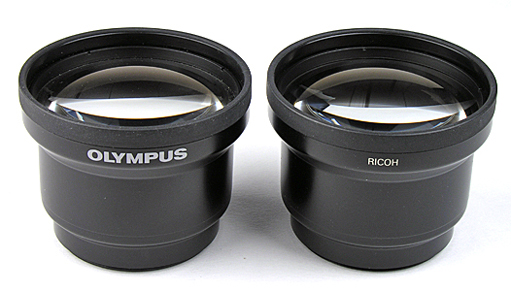
|
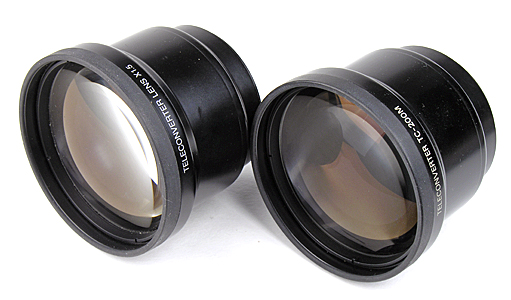
|
| Left: Olympus version Right: Ricoh TC-200M |
The following images show the TC-200M on a Mirai, and the Olympus version on an AZ-4.
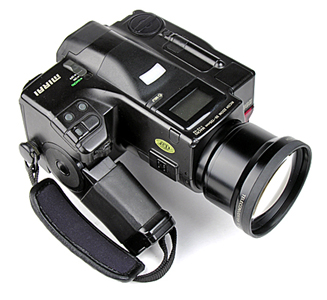
|
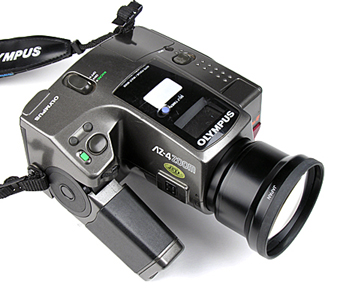
|
| Mirai with TC-200M | AZ-4 with Olympus version |